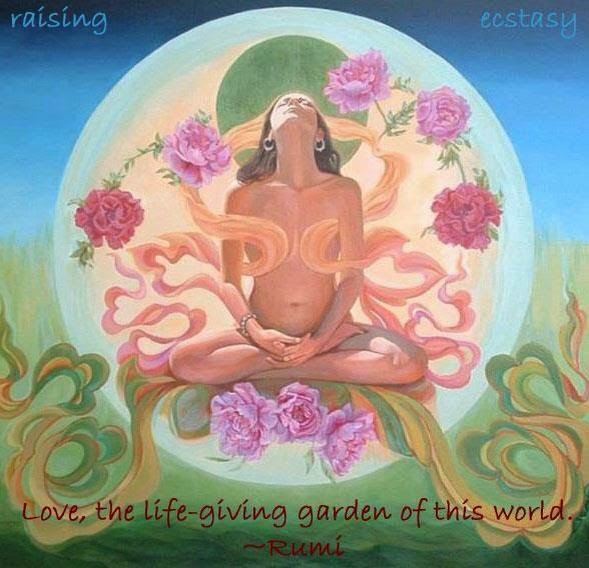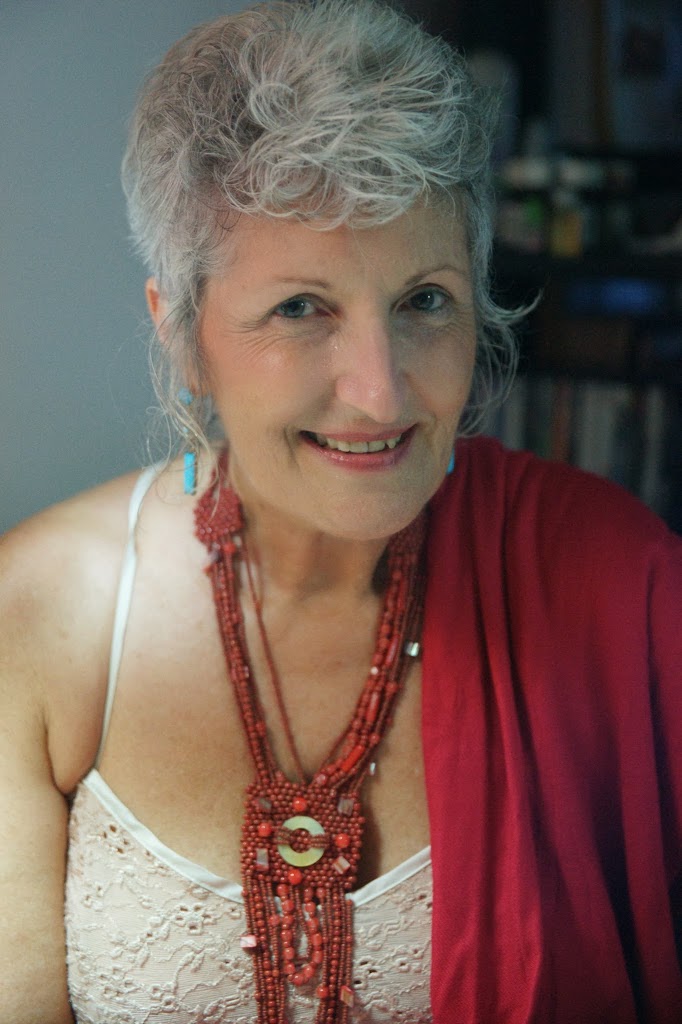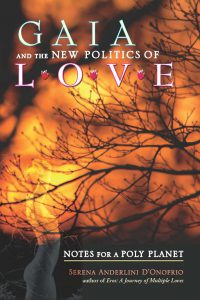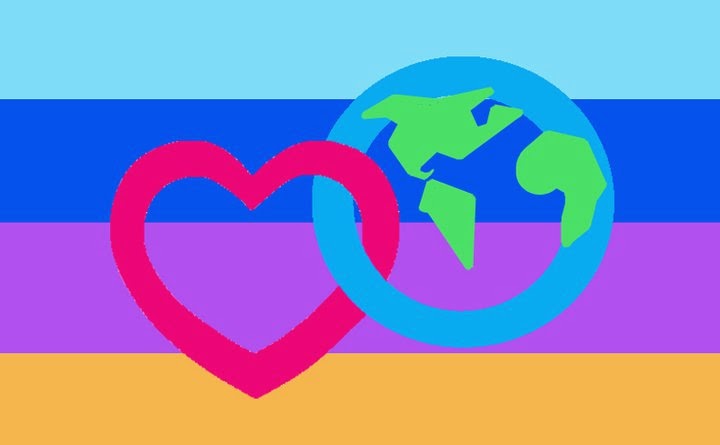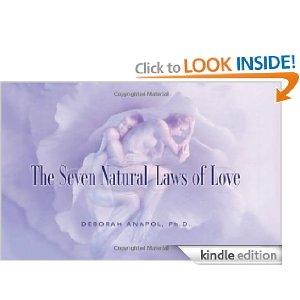Dear Earthlings:
The EcoSex course at U Conn is in process. It’s a great experience. We are expanding horizons with clustered reading: Theory of Science, Cultural Theory, Ecological Theory. We each read related books, then report to group. More thinking out of the box and across disciplines. Students are sending their book reports in. In class, we connect the dots. From a holograph of what we’ve read together, the “required readings.” What’s the connection with our clustered themes? Multiple perspectives and good synergy. Here, we offer a glimpse. Deborah Anapol’s Polyamory in the 21st Century is one of five “Cultural Theory” books. We got John to report on it.
John Nitowski:
A Book Report on Polyamory in the 21st Century: Love and Intimacy with Multiple Partners
by Deborah Anapol
–>
Dr. Anapol’s book Polyamory in the 21st Century takes a more academic tone than her other book The Seven Natural Laws of Love, but draws from the same sources. Dr. Anapol practices polyamory and has a lot of connections (professional and otherwise) with other polyamorists. Through mostly interviews, with some statistical research, Dr. Anapol presents the full picture of polyamory: the good and the bad.
 To clarify, “polyamory” is the practice of being openly intimate with more than one person at a time. It’s different from cheating on one’s spouses (because transparency is always a factor) and from swinging (because “swinging” in current connotations implies strictly physical relationships, though there is a strong connection to classical swinging and modern polyamory). As Dr. Anapol defines it, “I use the word polyamory to describe a whole range of lovestyles that arise from an understanding that love cannot be forced to flow or be prevented from flowing in any particular direction. Love, which is allowed to expand, often grows to include a number of people. But to me, polyamory has more to do with an internal attitude of letting love evolve without expectations or demands that it look a particular way than it does with the number of partners involved,” (1). Many polyamorous people come to the conclusion that, “lifelong monogamy is more of a mirage than a reality,” (2). The “monogamy mirage” is something of a product of modern society. It seems to produce dysfunctional families so while many people actively seek out polyamorous relationships, “most inadvertently discover that polyamory provides a very fertile environment for replicating any dysfunctional patterns carried over from the parental triangle experienced in their family of origin,” (20).
To clarify, “polyamory” is the practice of being openly intimate with more than one person at a time. It’s different from cheating on one’s spouses (because transparency is always a factor) and from swinging (because “swinging” in current connotations implies strictly physical relationships, though there is a strong connection to classical swinging and modern polyamory). As Dr. Anapol defines it, “I use the word polyamory to describe a whole range of lovestyles that arise from an understanding that love cannot be forced to flow or be prevented from flowing in any particular direction. Love, which is allowed to expand, often grows to include a number of people. But to me, polyamory has more to do with an internal attitude of letting love evolve without expectations or demands that it look a particular way than it does with the number of partners involved,” (1). Many polyamorous people come to the conclusion that, “lifelong monogamy is more of a mirage than a reality,” (2). The “monogamy mirage” is something of a product of modern society. It seems to produce dysfunctional families so while many people actively seek out polyamorous relationships, “most inadvertently discover that polyamory provides a very fertile environment for replicating any dysfunctional patterns carried over from the parental triangle experienced in their family of origin,” (20).
Somewhat shockingly, she opens the book with, “I have always characterized my position on polyamory as pro-choice rather than antimonogamy,” (ix). Dr. Anapol establishes that she is not out to convert us all to be polyamorists. Rather, she is here to show her readers that it is a viable alternative to serial monogamy. Of course a few pages later she writes, “In all honesty, after twenty-five years as a relationship coach, seminar leader, and participant observer in the polyamory community, I’m not at all sure that polyamory can fulfill its potential for sustainable intimacy,” (xv). It would seem that Dr. Anapol is apprehensive about the possibilities polyamory supposedly promises for society (more peaceful, more loving, more open, etc.) but reading the book a little closer reveals something different.
In Chapter 4 “The Ethics of Polyamory,” Dr. Anapol tells a story regarding a foursome under the heading “Unhealthy Monogamy leads to Unhealthy Polyamory,” (82). The story concerns two couples that got together to form a foursome: Vic and Christy met Alice and Jack at a party. They soon started a polyamorous relationship. While Christy and Jack developed “a sexual chemistry so strong that it was nearly palpable,” Vic was concerned that Christy would leave him for Jack, (83). When their foursome broke up, Christy and Vic were fine and had a thriving monogamous relationship. But the jealousy and pain was still apparent, Alice and Jack divorced not long after the event.
This episode highlights one of Dr. Anapol’s realizations about polyamory: “the form of the relationship is not so important… the form can change at any time. What accounts is allowing love to dictate the form rather than attempting to force love into whatever mold the mind has decided it right,” (ix-x). Like Diamond in Sexual Fluidity, Anapol seems to posit a sort of “relationship fluidity.” She includes lots of relationship combinations, for example, polygamy, polygyny, polyandry, group marriages, triads, dyads, Vs (where A dates B and C, but B and C aren’t dating), and Ns (where A and B are dating, but A dates C, and B dates D, but they aren’t dating anyone else). Polyamory is worthless if we can’t take the lessons we assume it promotes: open intimacy (sexual and emotional), a larger realm of love, decreased jealousy in favor of compersion, etc.
The chapter I was most interested to read was 7: “Polyamory and Children.” Whenever I ask monogamists what the purpose of marriage is, they tend to respond, “For the protection of children. Without laws in place, there’s nothing to keep fathers from just walking out,” (ironically, I heard this exact wording from a father). Not only does that sound absolutely absurd, that the instinct of fatherhood is held only in place by arbitrary laws, but I’ve seen too many parents who did walk out on their children. And not just fathers, but mothers as well. This isn’t to say monogamy is inherently bad, any more than Dr. Anapol shows the reader with her book that polyamory is not inherently good. But when it concerns raising children, the only advantage seems to be convenience. Several times in the book, Dr. Anapol expresses how nice it is to be able to go somewhere intimate with a partner and know her small children were well cared for at home. Otherwise, there don’t seem to be any actual beneficial or detrimental effects from raising children in a polyamorous home. Among the many stories Dr. Anapol includes, a woman describes her polyamorous lifestyle’s effect on her son, “I hear of the ups and downs of his relationships, just like any normal young man. So while I would like to say that our sexualoving lifestyle saved him such grief, I see that is not so. On the other hand, he sees the slings and arrows of his love life as part of his spiritual path, and I also notice that he truly honors his girlfriends and maintains friendships with odd lovers. As a mother, then, I do not worry about him,” (135). So really, she’s just describing a well-adjusted young man. Not that these are absent from monogamous relationships, but it stands to reason that polyamory’s emphasis on communication, openness, honesty, and a deeper understanding of unconditional love translates well to children.
This book is a great addition to our list (and I’m somewhat surprised it wasn’t required). I remember reading one story in Sexual Fluidity where a woman, not using any specific label to define herself, said she loved to date men because of the intensity, but loved dating women because of the intimacy. When she was with a woman, she missed the intensity of her male partners, but when she was with men, she missed the intimacy of her male partners. After reading the story, I wondered why she couldn’t have both and just be polyamorous? I think Dr. Anapol would ask the same question.
One of the more unexpected aspects to me (that I believe relates more immediately to concepts of Ecosexuality) is the way Osho looked at relationships. Bhagwan Shree Rajneesh, better known by his followers as Osho, was a spiritual guru in the ‘70s and ‘80s. He developed spiritual communes in Pune, India and Oregon. Osho praised “conscious monogamy as a very evolved form of relationship” however, “he was a severe critic of the traditional family, saying that it was ‘no longer relevant for the new humanity that was being born,’” (152). In Osho’s commune, children belonged to the community, and in order to expand awareness, adult sexual relationships were to be shared and free to prevent negative forms of attachment, what we would call jealousy, (93).
For me, this book was an incredible contrast to my own monogamous, Judeo-Christian upbringing. In school, I was told that “sex exists, and here’s all of the diseases you can get from it, also pregnancy.” In Osho’s ashram, the philosophy was that teenage sex, “was the most innocent, the most raw and pure of sexual experiences,” and that it, “could help to blossom people into sexually loving adults when it was not thwarted and laden with fear and moral judgment or hidden in secrecy and shame,” (152-3). Even though our society (as many of the books interviewed subjects have pointed out) seems to be content with the loneliness, despair, and depression that serial monogamy produces, I have not been. I was raised with three seemingly permanent parents who’ve had their ups and downs and saw several secondary father figures come and go. How very different can polyamory be for raising children if that’s our main concern? What is the advantages jealousy produces in a society so already laden with conflict, corruption, and envy?
Dr. Anapol’s book is academic in its approach, but poetic in execution. She is able to show how the philosophy behind having multiple sexualoving partners can open the doors to a more compersive and peaceful society. Dr. Anapol actually references Gaia and the New Politics of Love and describes how polyamory is conducive to the Gaia hypothesis. Patriarchal values (and it should be noted that much of what passes for polyamory is really old fashioned patriarchal polygyny, much of Mormon and Muslim sanctioned polygamy falls under this category) often place female dependence on male hegemony “over symbiosis or interdependence and direct bodily awareness,” (234). If we are able to begin practicing polyamory, not as a method of sexual gratification, but as an opening of awareness and love, as Osho proposed, then we can practice the arts of love in a sustainable way and open the doors to a loving society.
John Nitowski
Published with permission
WGSS 3998 – Ecosexuality and the Ecology of Love
Prof. Serena Anderlini-D’Onofrio
U Conn, Storrs, Spring 2013
Dear Earthlings:
Let “nature” be your teacher in the arts of love. Education is the heart of democracy, education to love. Come back for more wonders: Book Reports to appear every other Thursday. Book Reports to be scheduled soon. Check out our summer offerings: Ecosexuality in Portland, OR, July 17-21. Registration here!
Namaste,
Serena Anderlini-D’Onofrio, PhD
Gilf Gaia Extraordinaire
Author of Gaia, Eros, and many other books about love
Professor of Humanities
University of Puerto Rico, Mayaguez
Follow us in the social media
Author’s Page/Lists all books:





http://polyplanet.blogspot.com





